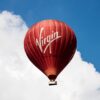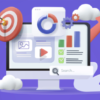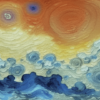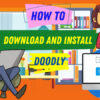Free
How To Build An Profitable Facebook Ads Funnel
Facebook ads can help you increase brand awareness, make people interested in your product or service, and lead to conversions. However, many businesses do not use Facebook ads well and either do not use them at all or use them inefficiently. In this guide, we will show you how to create a Facebook ad funnel that will be effective for your business.
Build Your First Funnel For Free!
What is a Facebook Ad Funnel?

A Facebook ad funnel is a way to track how people see your Facebook ad and then buy your product. The “Rule of 7” says that people need to see or hear a business message 7 times before they buy. That’s why it’s important to have a Facebook ad funnel. People usually don’t buy the first time they see your ad—it will take multiple touchpoints.
You need to understand your funnel so you can put the right ads on Facebook. Your goal is to always have ads that target people at different parts of the buying process.
The Stages of The Facebook Ad Funnel
What are the stages of a Facebook ad funnel?
Well, they’re the same as any other sales funnel.
Here they are!
Awareness
In the awareness stage, you want to get your brand in front of as many of the right people as possible. You want to create ads that make people interested in what you have to offer. Ads should be highly visual and focus on generating excitement about your product or service. When creating ads for this stage, think about the kind of ad that would stop you in your tracks while scrolling through Facebook.
Interest
Now that you have people’s attention, it is time to start building interest in your product or service. You want to create ads that will educate your target market about what you have to offer and how it can benefit them. Ads should be informative and highlight the key features and benefits of your product or service.
Consideration
Now that people know about your product or service, you need to get them to think about buying it. You can do this by creating ads that drive traffic to a landing page with a primary frontend offer.
Your ad should talk about why your product or service is the best option, and it should have plenty of social proof. Only show these ads to people who are interested in what you’re selling.
Purchase
The purchase stage is when people are finally ready to buy your product or service.
At this stage, you want to create ads that drive traffic to your checkout page or wherever people can make a purchase.
Your ads should include a strong call to action and clearly state the benefits of making a purchase.
You should also retarget people who have already shown interest in your product or service but haven’t made a purchase yet.
Loyalty
Once someone has bought something from you, your job is not done. You still need to take care of them and turn them into loyal customers. One way to do this is by running ads that promote customer loyalty and repeat purchases. This can be done by offering discounts for repeat customers, running ads that upsell or cross-sell products, or anything else that will make them want to come back and buy again. As you can see, each stage of the Facebook ad funnel requires a different type of ad. Now that we’ve gone over the stages of the funnel, let’s take a closer look at how to build one for your business.
The Top of The Funnel — Awareness/Interest
The first step in the Facebook ad funnel is to generate awareness and interest in your product or service. You do this by reaching new people who have never heard of your business before. This is called “cold traffic.” You can get their email address by creating a free lead magnet that is appealing to your target market. Then use saved audiences and lookalike audiences to drive those people to your landing page.
Saved Audiences
On Facebook, a “Saved Audience” allows you to “save your commonly used targeting options for easy reuse.”

This is ground zero for Facebook ad targeting.
By creating a saved audience, you’ll simply be leveraging Facebook’s deep knowledge of its users to target people who fit the interests, behaviors, and demographics of your target market.
How do you do that effectively?
Start by answering this question: who are your dream customers?
Ideally, you’ve taken the time to create an in-depth customer avatar and you have questions to more in-depth questions such as…
- What is their biggest fear?
- What is their biggest desire?
- What do they love more than anything?
- How much money do they make?
- What are their primary points of frustration?
If you don’t, start by creating your customer avatar.
If you do know your target market, the next step is to figure out how you can translate what you know into savvy Facebook targeting.
For example, I once created audiences I called “College Grads With Ambition”, “Ambitious Stay-At-Home-Moms”, and “Struggling Entrepreneurs.”
Here’s what the targeting for those looked like on Facebook.
“College Grads With Ambition”…

“Ambitious Stay-At-Home Moms”…

And “Struggling Entrepreneur”…

See how I turned each of my customer avatars into specific Facebook-saved audiences?
You can do the same.
Lookalike Audiences
Another top-of-funnel Facebook ad targeting trick is using lookalike audiences.
A lookalike audience is a way to reach new people who are likely to be interested in your business because they’re similar to your best existing customers.
In other words, Facebook allows you to find more people who are like your best customers and then show your ads to those people.

How does Facebook create lookalike audiences?
Facebook looks for similarities among your best customers. For example, if you have a list of email addresses from your best customers, you can upload that list to Facebook and create a lookalike audience. If you have existing customers to use for this, it’s a whole lot easier (and typically more effective) than creating saved audiences.
You can also create a lookalike audience based on engagement with your Facebook page, app, or event.
The people you’re targeting will still be “cold traffic” since they’ve never heard of your business before — so this targeting trick still is considered to be top-of-funnel.
Lead Magnets
Generating leads from cold traffic can be tough. However, you can make it easier by offering something in return for their contact information. This is called a lead magnet and it needs to be something that your target market wants. You can give it away for free in exchange for their email address. For example, here’s an offer we use to capture email addresses from people who visit our blog…

The idea is simple: give your dream customers something they want in exchange for their email addresses.
To be effective, your lead magnet needs to be high quality and it needs to be closely related to what you’re selling.
For example, if you’re selling a course on how to start a blog, your lead magnet shouldn’t be an ebook on dog training.
Instead, it should be something that’s closely related — like a checklist of the steps needed to start a blog or a video tutorial on how to start a blog.
Here are some additional tips…
- Your lead magnet should be something that’s evergreen, meaning it will be relevant and useful to people for a long time.
- It should also be something that’s specific and actionable.
- People should be able to consume it quickly and then take action on what they learned.
- This could be a PDF guide, an email course, a video tutorial, or even just a simple checklist.
- The sky is the limit, but make sure it’s something that people will actually want to consume.
- The lead magnet should be located on a landing page, which is a standalone web page designed for one purpose: converting visitors into leads.
If you’re not sure what kind of lead magnet would work best for your business, check out our full guide to creating a lead magnet over here.
The Middle of The Funnel — Consideration/Purchase
Once you’ve captured someone’s email address with a lead magnet, you can start moving them further down the funnel with more targeted content.
This is typically called “middle of the funnel” or “MoFu” content.
It’s designed to get people interested in your products or services and start considering a purchase.
For this phase of your Facebook ad funnel, you can leverage retargeting ads, tripwire funnels, influencer marketing, and affiliate advertising.
Build Your First Funnel For Free!
Retargeting Ads
You’ve probably been retargeted by a business before — it’s when you visit a website and then start seeing ads from that company everywhere you go.
For example, let’s say you buy a pair of shoes from an online retailer. A few days later, you noticed that you’re seeing ads for those same shoes (and other items from that retailer) on Facebook, Instagram, and even YouTube.
That’s retargeting in action.

Retargeting is an incredibly powerful way to generate sales from people who have already shown an interest in what you’re selling — which makes it perfect for the middle of the funnel.
Check out some of these stats (Truelist)…
- Retargeting reduces cart abandonment by 6.5%.
- 68% of marketing agencies now have an allocation for remarketing.
- 17.5% of apps running retargeting see a 25% conversion rate.
- Retargeting beats all other ad placement strategies with a 1,046% efficiency rate.
So how should you use retargeting ads?
Here are some ideas…
- If you sell physical products, you can retarget people who’ve visited your website but didn’t purchase anything.
- You can also retarget people who started the checkout process but didn’t complete their purchase.
- If you sell digital products, you can retarget people who downloaded your freebie but didn’t purchase your upsell.
There are endless possibilities — it just depends on what you’re selling and how effective your behavioral tracking is.
Tripwire Funnels
Tripwire funnels are a great way to sell products to cold or lukewarm traffic — they’re perfect for the middle of the funnel.
Let’s take a look at an outline of the Tripwire Funnel…

Here are some more details with examples of each page…
Two-Step Sales Page — First, visitors arrive at the sales page. This page offers such a no-brainer deal that your target market can’t possibly resist. It’s sort of like a lead magnet except you’re offering it for a small amount of money, usually anywhere from $1 to $50 (depending on your industry and target market). This page requires people to enter their shipping and payment information to continue through the funnel.

OTO Page — Next, visitors go to the One-Time Offer Page. This page offers the thing that you’re actually trying to sell. It’s a bit more expensive than the thing you offered on the first page but heavily discounted and with some strong FOMO since it’s a one-time offer. The typical friction of inputting shipping and payment information is already taken care of (that’s where most people abandon their shopping cart) and so the OTO Page usually converts at a surprisingly high rate.

Offer Wall Page — This is your receipt and/or thank you page.

Tripwire Funnels do really well for converting cold traffic into customers or for getting warm leads who’ve never purchased before to finally take the leap.
If this sounds like the ticket, you can download your first Tripwire Template over here for free — then you can customize it however you like using ClickFunnels’ software.
Influencer Marketing
Influencer marketing is basically when you get people with a lot of followers in your target market to promote your product or service.
It’s one of the most effective ways to reach your target audience because people listen to and trust influencers more than they trust businesses.

Think about it…
If one of your favorite celebrities or bloggers promoted a product on their Instagram page, you’d be way more likely to check it out than if you saw an ad for that same product, right?
The reason influencer marketing is so effective is that social media has made celebrities and thought leaders out of regular people.
Anyone with a large social media following has the ability to influence their followers — and that’s exactly what you want to take advantage of.
There are two main ways to use influencer marketing in your sales funnel…
The first way is to find relevant influencers in your target market and offer them a free trial of your product in exchange for a review or mention on their page.
The second way is to actually pay an influencer to promote your product (this is what most businesses do) — you can do that either by paying them a flat fee or paying them a commission for every sale that they make.
To be as effective as possible with your influencer marketing efforts, we recommend following our Dream 100 process outlined over here.
The Bottom of The Funnel — Loyalty
The bottom of the funnel is all about customer loyalty and advocacy.
This is where your customers have already been through your entire sales funnel and they’ve become a part of your tribe — they know, like, and trust you.
Now it’s time to turn them into loyal fans who will buy everything you launch and who will also tell all their friends about you.
To do that, you can use cross-selling ads, upsell ads, and referral program ads.
Cross-selling Ads
Cross-selling ads are designed to get your customers to buy other products that complement the product they’ve already purchased from you.
For example, let’s say you sell skincare products and someone just bought your face wash. A cross-selling ad might be for your toner, serum, moisturizer, etc. — basically, anything else that someone would need to complete their skincare routine.

These are good for loyalty because… the more people buy from you, the more loyal they’ll be to your brand.
Upsell Ads
Upsell ads are designed to get your customers to buy a higher-priced version of the product they just purchased from you.
For example, let’s say you sell a software subscription for $97/month and someone just signed up. An upsell ad might be for a higher-priced subscription that includes additional features, more one-on-one support, etc.
Referral Program Ads
Referral program ads are designed to get your customers to refer their friends to your business.
For example, let’s say you give your customers a $10 discount for every friend they refer who makes a purchase. A referral program ad would be an ad that explains the referral program and encourages people to take advantage of it.

Final Thoughts on Facebook Ad Funnels
This article explained how Facebook ad funnels work. You can use them to grow your business. The key to success with Facebook ad funnels is to start with a specific audience, product, or offer. Then you can gradually expand your reach. If you’re ready for the next step, click the link below to build your first sales funnel for free!
Click the link below if you’re ready for the next step — to build your high-converting sales funnel that will make the most of your marketing efforts!
>>>Launch Your First (Or Next) 7 Figure Funnel In 10 Minutes Or less!
>>>Join The One Funnel Away Challenge<<<






























